
North by Northwest is considered one of the best Hitchcock films ever made. It was also one of the most commercially successful. The movie follows the classic Hitchcock “Wrong Man Scenario.” Cary Grant is a successful Madison Avenue ad man (think Don Draper) who says things like, “There’s no such thing as a lie. There’s only the expedient exaggeration.”
Then his life gets turned upside down when he gets mistaken for an undercover CIA agent. He’s swept up in a game of cat and mouse that takes him across the country and eventually to the top of Mt. Rushmore for that classic chase scene across the presidents’ faces.

This cool Modernist house, perched on the peak of Mt. Rushmore, is what a lot of us remember most about the movie, right? I’ve gotten a lot of requests for photos of it. And we’ll get to the Vandamm House, as it’s known, but first let’s start back at the beginning of the story.
Roger Thornhill (Grant) is having lunch in the Oak Room of the Plaza Hotel when a couple of thugs force him into their car at gunpoint. They think he’s an undercover agent named George Kaplan.They filmed these scenes on location, and Cary Grant lived in an apartment at the Plaza during filming:

The bad guys drive him here, to the Townsend Estate in Long Island:
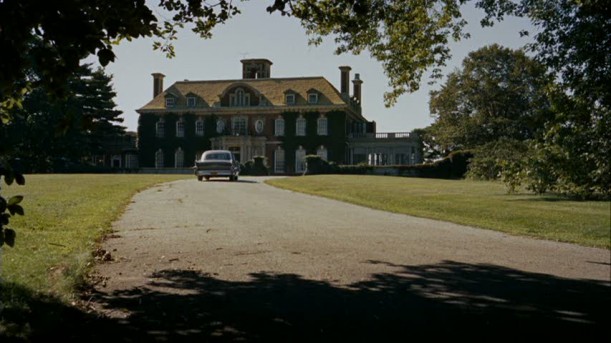
Townsend Mansion was a real estate in Glen Cove, Long Island, but the interiors were a set. The estate is known as Old Westbury Gardens, and they provide tours of the home. You can see some cool photos of it being built in 1905 and read about its history here.
The estate as it looks today:

Jessie Royce Landis (below), the actress who played Grant’s mother in the movie, was in reality only 8 years older than he was:

The set designers were Robert Boyle, William A. Horning, Merrill Pye, Henry Grace, and Frank McKelvey.

The library that Thornhill gets locked in. He says, “Don’t worry about me. I’ll catch up on my reading.”
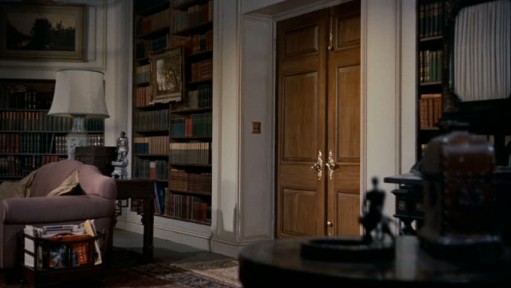
Screenwriter Ernest Lehman says Grant was a perfectionist who often complained about various parts of the script or the way things were being filmed and lobbied to get them changed.
North by Northwest turned out to be Grant’s biggest box-office success.
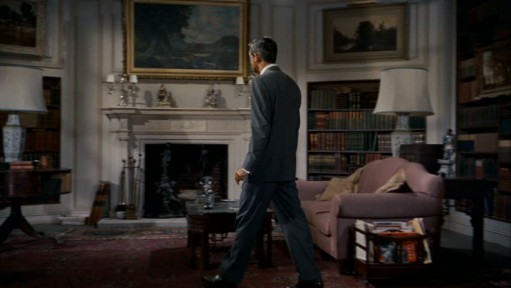
James Mason played the baddie, Phillip Vandamm, and Martin Landau was perfect as his sinister-looking associate. Hitchcock loved using overhead shots like these. I appreciate them because we get a good look at the rugs:

After escaping from Vandamm’s thugs, Thornhill went to the U.N. to try to figure out what was going on.
Hitchcock wasn’t allowed to film there, so they “stole” a shot of the U.N. exterior with Cary Grant walking in. The other people walking around in the shot didn’t know they were being filmed, or that Grant was walking beside them. (Can you imagine? “Hey, that’s me!”)
The interior of the U.N. was (quite obviously) a matte painting:
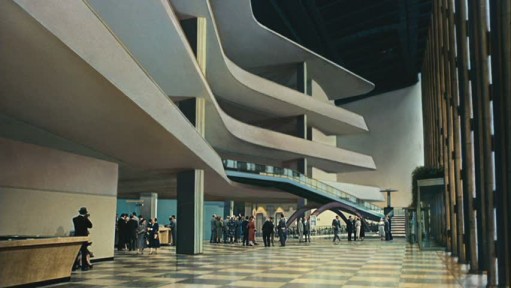
The backdrop was on display in Grand Central Terminal a few years ago, as part of a Turner Classic Movies exhibit on movies set in NYC. A reader sent me this photo of the matte painting:
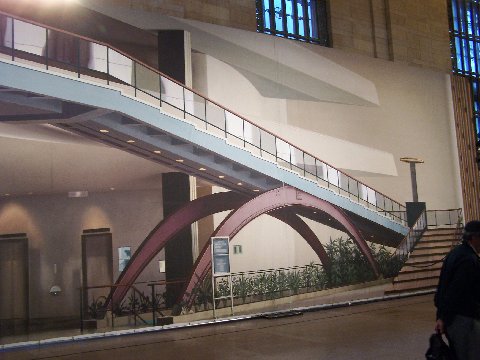
The screenplay was written by Ernest Lehman, who won more Best Screenplay Awards from the Writer’s Guild than anyone in history. He was the screenwriter behind other classics like The King and I, West Side Story, Sabrina, and The Sound of Music.

Lehman died in 2005 at the age of 89, so we’re fortunate that he recorded a detailed commentary about North by Northwest.
Hitchcock told him, “I always wanted to do a chase scene across the faces of Mt. Rushmore,” and that was the starting point for the movie. Lehman recalled, “I wanted to write the Hitchcock picture to end all Hitchcock pictures. I wanted something that had wit, sophistication, glamor, action, and lots of changes of locale.”
For the famous crop-duster sequence, they planted some corn in Bakersfield, California, to make it look more like Indiana:

After Thornhill miraculously survives (and the pilot of the plane doesn’t), he surprises Eve by showing up at her room in the Ambassador East Hotel in Chicago. He’s a little dusty but every hair is still in place.
I thought the hotel decor was pretty cool:

The movie was a little racy for the late ’50s. It may not have shown much, but it insinuated a lot about what Roger and Eve were doing when the cameras looked away.
In the dining car in the train, Eve coos, “I never make love on an empty stomach.” It was censored in post-production to “I never discuss love on an empty stomach,” but if you read her lips you can see what she was really saying.

The crew traveled to South Dakota, and Eva Marie Saint, Cary Grant, and James Mason posed for the press before shooting on it was supposed to begin.
Then word leaked that there would be a fight scene and a couple of deaths on the monument, and the government officials barred them from filming it there. The crew flew back to Hollywood, where Mt. Rushmore had to be recreated at MGM.
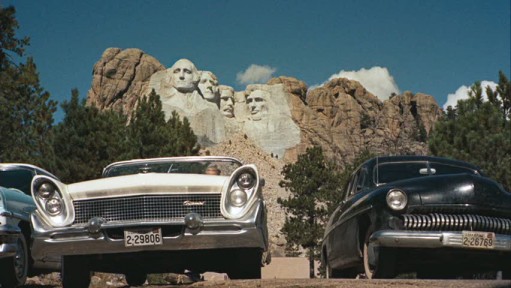
Those are real shots of the monument from the distance. The rest was Production Designer Robert Boyle’s creation back at the studio.
“I don’t like the way Teddy Roosevelt’s looking at me,” Roger says when looking up at the monument. “I think he’s trying to tell me not to go through with this hare-brained scheme.”

Thornhill meets Van Damm and his crew at the community parks building near the monument, and even it had style:
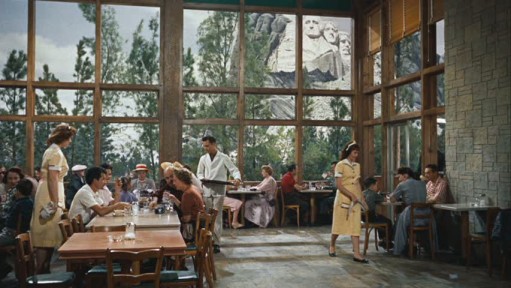
Check out the cool checkered-wood walls in the cafeteria:
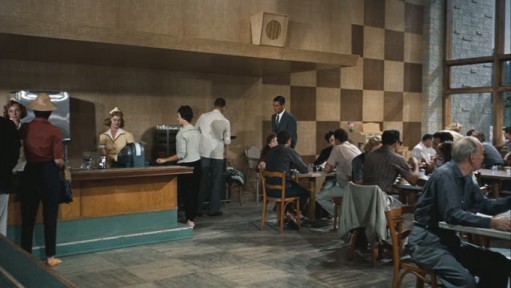
In the scene where Eve (Eva Marie Saint) shoots Roger (Grant), can you spot the mistake in the background?

The little boy at the table behind Eva Marie Saint plugged his ears, knowing the gun was about to go off. I always get a kick out of that!
The Vandamm House:
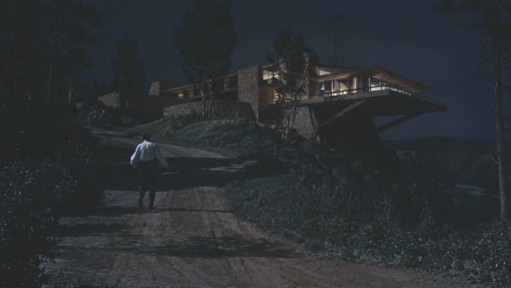 They needed to come up with a reason why all of the characters would be congregating at Mt. Rushmore, so Lehman decided that the bad guys would have their headquarters nearby. It’s known as “The Vandamm House” after James Mason’s character, Phillip Vandamm.
They needed to come up with a reason why all of the characters would be congregating at Mt. Rushmore, so Lehman decided that the bad guys would have their headquarters nearby. It’s known as “The Vandamm House” after James Mason’s character, Phillip Vandamm.

A lot of people have asked me whether it’s a real house, and if it’s really on top of Mt. Rushmore. Sadly, no, it’s not real. The exterior was a matte painting (a pre-digital effect when a real set or location was combined with a painting), and the interior was created on a soundstage.
In reality, there is no way anything could be built on top of the monument, even temporarily for a film.

According to a fascinating post on Jetset Modern, Hitchcock knew he wanted it to be a Modernist house. In the late ’50s, Frank Lloyd Wright was the most famous Modernist architect in the world. Any house he designed for the film would have been instantly recognizable to audiences.
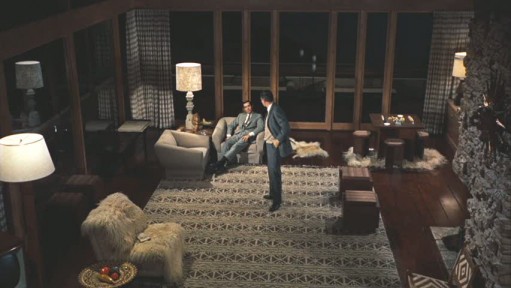
The problem: they couldn’t afford Wright’s fee. So Hitchcock decided they’d just build a house that looked like one Wright would have designed.

The second problem: the top of Mt. Rushmore was too fragile to build anything on it. The MGM researchers had to get special permits and Park Service escorts just to visit the area in order to photograph and measure it.

According to Sandy McLendon of Jetset Modern:
The house would be created entirely in Culver City, where MGM was located. It would consist of a few sections built at full-scale, as movie sets. The exterior shots would depend on special effects. Certain shots would blend the sets together with the special effects, to create the illusion that the house was real. The final design was of a hilltop house of limestone dressed and laid in the manner made famous by Wright, along with a concrete cantilever under the living room area.
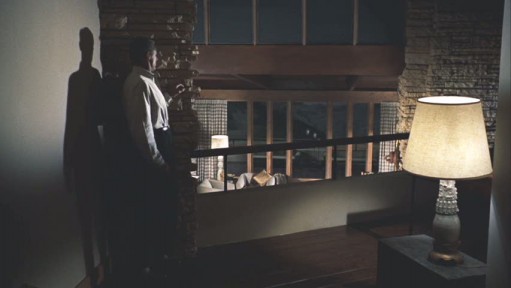
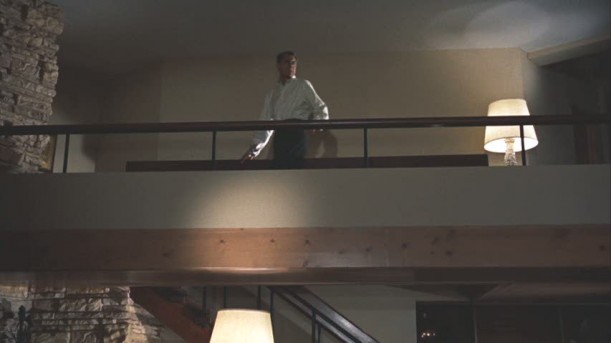
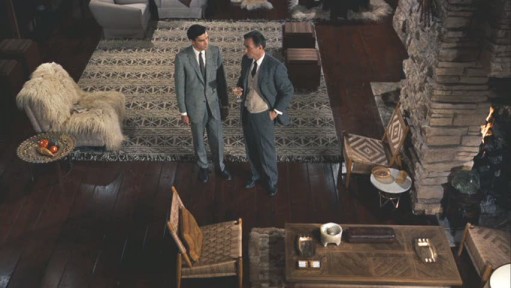
Just when he thinks he’s in the clear, Vandamm’s housekeeper pulls a gun on Thornhill:

McLendon explains how the set was designed:
Certain areas like the outside of the bedroom wing had their exteriors finished, so that they could be shot from inside looking out, or outside looking in.
The interiors were masterpieces of deception: nearly nothing was what it appeared. The limestone walls were mostly plaster, real limestone was used in a few places where the camera would be very close. The expanses of window were mostly without glass; glass reflects camera crews and lights.

All of the scenes involving the Vandamm house were shot at night so that the effects would look more realistic. Read more about it and see examples of how the matte photography technique worked here. (Thanks to Lyle for the info!)
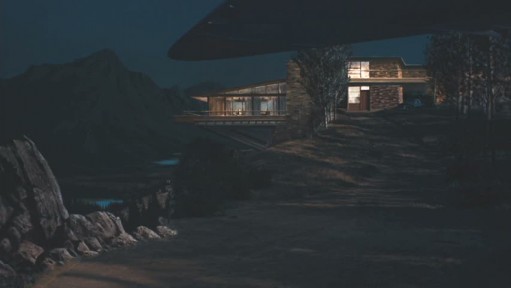
More North by Northwest Movie Trivia:
- North by Northwest was just the working title, but they never came up with anything better. One they considered: The Man in Lincoln’s Nose. (Seriously.)
- Jimmy Stewart was originally considered for the role of Thornhill, but Hitchcock decided he looked “too old.” Cary Grant was 55 when he filmed it–4 years older than Stewart–but looked younger.
- MGM wanted Cyd Charisse in the role of Eve Kendall, but Hitchcock insisted on Eva Marie Saint.
- MGM designed an entire wardrobe for Saint’s character, but Hitchcock threw out almost everything. She says he took her to Bergdorf-Goodman and selected clothes for her “right off the models.”
- Hitchcock gave Saint three basic directions: 1) Lower your voice. 2) Don’t use your hands. 3) Always look directly into Cary Grant’s eyes.
- North by Northwest was nominated for 5 Oscars but lost in every category.
The movie trailer, humorously presented by Alfred Hitchcock himself:
What’s your favorite Hitchcock movie? I just watched Rebecca again last week (you can see my post about Manderley here). Hitchcock knew how to work a great house into a suspenseful movie!
Visit my TV/Movie Houses page to see other classics I’ve featured, from Mr. Blandings Builds His Dream House to Gone with the Wind.
No comments:
Post a Comment